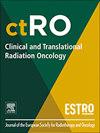商业软件对治疗前和近距离放疗前MRI一阶放射学特征作为宫颈癌放疗的生存预测指标
IF 2.7
3区 医学
Q3 ONCOLOGY
引用次数: 0
摘要
材料与方法该研究纳入了100名接受了IMRT/VMAT技术的CCRT后再接受3D-IGABT的LACC患者。基于磁共振成像的轮廓绘制包括原发肿瘤(GTVp)和淋巴结(GTVn)的 T2WI 和 DWI 图像。轮廓图被导入 MIM 软件,以提取一阶放射学特征。使用单变量和多变量考克斯回归分析法分析了治疗前(PreRx)、近距离放疗前(PreBT)的放射学值、PreRx 和 PreBT 之间的放射学差异(Diff)以及临床因素。结果中位随访时间为 24.5 个月。2年的PFS、LRFS、DMFS和OS率分别为71%、88.6%、83.1%和83.5%。在所有临床结果中,与单独使用 CF 或 RF 相比,PreRx 和 PreBT 的 CF + RF 组合的 Harrell's C 指数最高。与 Diff 模型相比,PreRx 和 PreBT 模型的哈雷尔 C 指数更高。来自PreRx和PreBT的CF + RF模型的PFS、LRFS、DMFS和OS的C指数分别为0.739、0.873、0.830和0.967,乐观指数分别为0.312、0.381、0.316和0.242。来自 PreRx 和 PreBT 的临床和放射组学组合预测模型的性能最高。本文章由计算机程序翻译,如有差异,请以英文原文为准。
Pre-Treatment and Pre-Brachytherapy MRI first-order Radiomic Features by a Commercial software as survival predictors in radiotherapy for cervical cancer Objectives
Materials and Methods
The study included 100 patients with LACC who underwent definitive CCRT with IMRT/VMAT technique followed by 3D-IGABT. MRI-based contouring included T2WI and DWI images for primary tumor (GTVp) and lymph nodes (GTVn). The contours were imported to MIM software to extract first-order radiomic features. Radiomic values from pre-treatment (PreRx), pre-brachytherapy (PreBT), differences between PreRx and PreBT (Diff) radiomic and clinical factors were analyzed using univariate and multivariate Cox regression analysis. Predictive models of PFS, LRFS, DMFS, and OS were created along with the optimism index and calibration plot.
Results
The median follow-up time was 24.5 months. The 2-year of PFS, LRFS, DMFS, and OS rates were 71, 88.6, 83.1, and 83.5 %, respectively. For all clinical outcomes, CF + RF combined from PreRx and PreBT resulted in the highest Harrell’s C-index compared with the CF or RF alone. Compare with Diff models, models from PreRx and PreBT resulted in higher Harrell’s C-index. The C-indexes from the CF + RF model from PreRx and PreBT for PFS, LRFS, DMFS, and OS were 0.739, 0.873, 0.830 and 0.967 with the optimism indexes of 0.312, 0.381, 0.316, and 0.242, respectively.
Conclusion
Radiomic features from the first-order statistics added values to clinical factors to predict the outcomes after CCRT. The highest prediction model performance was for the combined clinical and radiomics from PreRx and PreBT.
求助全文
通过发布文献求助,成功后即可免费获取论文全文。
去求助
来源期刊

Clinical and Translational Radiation Oncology
Medicine-Radiology, Nuclear Medicine and Imaging
CiteScore
5.30
自引率
3.20%
发文量
114
审稿时长
40 days
 求助内容:
求助内容: 应助结果提醒方式:
应助结果提醒方式:


